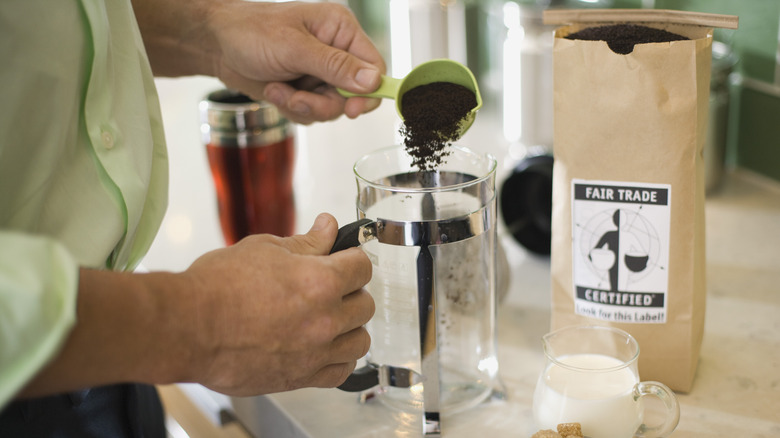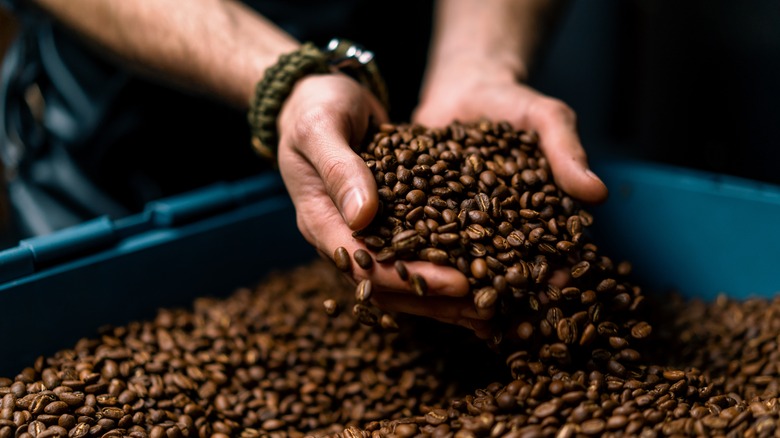The Right Way To Use The Flavor Notes On Your Bag Of Coffee
You've seen the flavor notes on a bag of coffee. Maybe it says "rich with notes of chocolate and berries" or "bright, citrus flavors with a hint of melon." They're not defining flavored coffee, but flavors found in the coffee beans.
The whole point of these flavor notes is that they help you anticipate what flavors and aromas you'll experience in a cup of coffee. They help you choose beans you know you'll like, or expand your coffee tasting horizons by choosing something you've never had before. Sometimes, it's pretty easy — you likely know what lemon or chocolate tastes like. But what's a "grassy" flavor? Are we talking fresh-cut Kentucky blue grass or wispy prairie grass? Does "earthy" refer to the dark, rich loam of a New England forest, littered with last season's fallen leaves? Or is it the dusty clay earth of the red-rocked American Southwest? And what, for the love of coffee, does "fresh" taste like?
It's necessary to have a standardized set of flavor descriptors to proficiently discuss them, especially when they're not as ubiquitous as "grapefruit." The Coffee Taster's Flavor Wheel was developed by the Specialty Coffee Association in 1995 and revised based on the 2016 World Coffee Research Sensory Lexicon, a research project from the Sensory Analysis Center at Kansas State University. This tool is what pros in the industry use to define the flavors present in your cup of coffee, and you can use it to figure out what the heck they mean.
Decoding the flavor wheel
Brewed coffee has over 800 aromatic compounds. The flavor wheel organizes these into 110 flavors you might encounter in your cup. The center of the wheel is the broadest; it has nine categories: fruity, sweet, floral, roasted, spices, nutty/cocoa, sour/fermented, green/vegetative, and other.
The next layer outward breaks that down even further. The fruity category, for example, has sub-categories such as berry, dried fruit, other fruit, and citrus fruit. In a world where any fruit can be dried, what does dried fruit mean? So glad you asked — the outermost layer offers more specifics: raisin and prune. "Other fruit" is defined by coconut, cherry, pomegranate, pineapple, grape, apple, peach, and pear. Chances are, you probably know what most of those flavors are and can easily translate them to what you'll find in your cup of coffee.
When you get to the flavors you're less likely to have instant taste recall for, like "ashy," or "brown, roast" or "butyric acid," there's another tool to use. The Not Bad Coffee project used the lexicon report to make an interactive wheel complete with flavor cards with information about what each flavor equates to. "Earthy" does mean damp, black soil after all. Butyric acid is "a sour, fermented-dairy aromatic associated with certain aged cheeses such as Parmesan." Want to figure out what "brown, roasted" tastes like? Open up a can of Bush's pinto beans, believe it or not. It's somewhere between that and C&H golden caster sugar.
Choosing coffee when there are no flavor notes
If you intentionally look for the flavor notes in coffee, you'll come to know what flavors you do and don't like. Maybe you like citrusy flavors, or maybe the acidity makes your face scrunch up. Maybe you hate notes of tomato in your coffee, or maybe the nostalgia of picking cherry tomatoes in your grandmother's garden is as warm and comforting as the liquid in your cup. Maybe you love caramel and cinnamon notes but hate clove and molasses. But how do you choose if there are no tasting notes on the bag?
There are two things to pay attention to if there are no flavor indicators: roast level and geography. As the beans roast, they lose their citrusy, vegetal, and floral notes that can still be found in a light roast and develop toastiness from the Maillard reaction as they enter a medium roast, through to almost burning the plant fibers in a dark roast.
If you love a citrusy, herbal, or very berry coffee, look for a Kenyan or Ethiopian light roast. Prefer a cup tasting like caramel, chocolate, vanilla, and honey? A medium roast from Colombia, Hawaii, or Costa Rica should be right. If you're looking for smokiness and baking spices, you'll probably find them in an Indian or Brazilian dark roast. These aren't bulletproof heuristics, of course, but the terroir and roast level can guide you. Once you start learning the wheel, you'll be a pro in no time.


